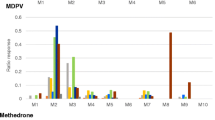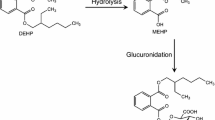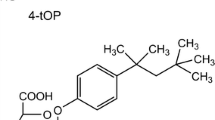Summary
The pathways by which pinazepam and diazepam are metabolized by rat microsomesin vitro were studied in detail. Using a gas chromatographic technique to measure either the two parent compounds or their metabolites, it was demonstrated that pinazepam and diazepam were metabolized through the same pathways, but at different rates. Pinazepam was mainly N-dealkylated, while the C3-hydroxylation was a minor metabolic pathway. Diazepam was mostly C3-hydroxylated, with very little being N-demethylated. The different rats for the two metabolic pathways could be of importance in differentiating the action of the two drugsin vivo.
Similar content being viewed by others
References
Scrollini F., Caliari S., Romano A. and Torchio P. (1975): Toxicological and pharmacological investigations of pinazepam (7-chloro-1-propargyl-5-phenyl-3H-l,4-benzodiazepin-2-one): A new psychotherapeutic agent.Arzneimittel-Forsch., 25, 934–940.
Menchini Fabris F., Bianchi B., Berni G.L. and Mariani M. (1976): Prova controllata con pinazepam in soggetti endocrinopatici.Chimica Terapeutica, 11, 543–551.
Antonelli F., Di Donato R., Idone F., Pariante F. and Saraceni C. (1975): Sperimentazione clinica del pinazepam in medicina psicosomatica.Mediana Psicosomatica, 20, 217–232.
Garattini S., Marcucci F. and Mussini E. (1977): The metabolism and pharmacokinetics of selected benzodiazepines. In:Psychotherapeutic Drugs part 11: Applications. E. Usdin and I.S. Forrest ed. Dekker, New York, pp. 1039–1087.
Lowry O.H., Rosebrough N.J., Farr A.L., and Randall R.J. (1951): Protein measurement with the folin phenol reagent.J. biol. Chem. 193, 265–275.
Kato R. and Takayanaghi M. (1966): Differences among the action of phenobarbital, methylcholanthrene and male sex hormone on microsomal drugmetabolizing enzyme systems of rat liver.Jpn. J. Pharmacol., 16, 380–390.
Garattini S., Mussini E., Marcucci F. and Guaitani A. (1973): Metabolic studies on benzodiazepines in various animal species. In:The Benzodiazepines. S. Garattini, E. Mussini, and L.O. Randall ed. Raven Press, New York, pp. 75–97.
Garattini S., Marcucci F., Morselli P.L. and Mussini E. (1973): The significance of measuring blood levels of benzodiazepines.In:Biological Effects of Drugs in Relation to their Plasma Concentration. D.S. Davies and B.N.C. Prichard ed. MacMillan, London, pp. 211–225.
Trebbi A., Gervasi G.B. and Comi V. (1975): Determination of pinazepam and its metabolites in serum, urine and brain by gas-liquid chromatography and mass spectrometry.J. Chromatogr., 110, 309–319.
Marcucci F., Bianchi R., Airoldi L., Salmona M., Fanelli R., Chjiabrando C., Frigerio A., Mussini E. and Garattini S. (1975): Gas chromatographic-mass spectrometric determination of intact C3-hydroxylated benzodiazepine glucuronides in urine.J. Chromatogr. 107, 285–293.
Author information
Authors and Affiliations
Rights and permissions
About this article
Cite this article
Marcucci, F., Airoldi, L., Zavattini, G. et al. Metabolism of pinazepam by rat liver microsomes. European Journal of Drug Metabolism and Pharmacokinetics 6, 109–114 (1981). https://doi.org/10.1007/BF03189476
Received:
Issue Date:
DOI: https://doi.org/10.1007/BF03189476




